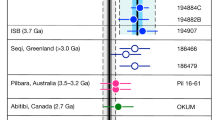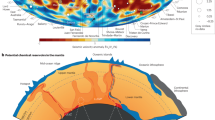Abstract
Many precious, ‘iron-loving’ metals, such as gold, are surprisingly abundant in the accessible parts of the Earth, given the efficiency with which core formation should have removed them to the planet’s deep interior1. One explanation of their over-abundance is a ‘late veneer’—a flux of meteorites added to the Earth after core formation as a ‘terminal’ bombardment that culminated in the cratering of the Moon2. Some 3.8 billion-year-old rocks from Isua, Greenland, are derived from sources that retain an isotopic memory of events pre-dating this cataclysmic meteorite shower3,4. These Isua samples thus provide a window on the composition of the Earth before such a late veneer and allow a direct test of its importance in modifying the composition of the planet. Using high-precision (less than 6 parts per million, 2 standard deviations) tungsten isotope analyses of these rocks, here we show that they have a isotopic tungsten ratio 182W/184W that is significantly higher (about 13 parts per million) than modern terrestrial samples. This finding is in good agreement with the expected influence of a late veneer. We also show that alternative interpretations, such as partial remixing of a deep-mantle reservoir formed in the Hadean eon5,6 (more than four billion years ago) or core–mantle interaction7, do not explain the W isotope data well. The decrease in mantle 182W/184W occurs during the Archean eon (about four to three billion years ago), potentially on the same timescale as a notable decrease in 142Nd/144Nd (refs 3 and 6). We speculate that both observations can be explained if late meteorite bombardment triggered the onset of the current style of mantle convection.
This is a preview of subscription content, access via your institution
Access options
Subscribe to this journal
Receive 51 print issues and online access
$199.00 per year
only $3.90 per issue
Buy this article
- Purchase on Springer Link
- Instant access to full article PDF
Prices may be subject to local taxes which are calculated during checkout


Similar content being viewed by others
References
Kimura, K., Lewis, R. S. & Anders, E. Distribution of gold and rhenium between nickel-iron and silicate melts—implications for abundance of siderophile elements on Earth and Moon. Geochim. Cosmochim. Acta 38, 683–701 (1974)
Chou, C.-L. Fractionation of siderophile elements in the Earth’s upper mantle and lunar samples. Proc. 9th Lunar Planet. Sci. Conf. 9, 163–165 (1978)
Caro, G., Bourdon, B., Birck, J. L. & Moorbath, S. High-precision 142Nd/144Nd measurements in terrestrial rocks: constraints on the early differentiation of the Earth’s mantle. Geochim. Cosmochim. Acta 70, 164–191 (2006)
Kamber, B. S., Collerson, K. D., Moorbath, S. & Whitehouse, M. J. Inheritance of early Archean Pb-isotope variability from long-lived Hadean protocrust. Contrib. Mineral. Petrol. 145, 25–46 (2003)
Carlson, R. W. & Boyet, M. Composition of the Earth’s interior: the importance of early events. Phil. Trans. R. Soc. Lond. A 366, 4077–4103 (2008)
Bennett, V. C., Brandon, A. D. & Nutman, A. P. Coupled 142Nd-143Nd isotopic evidence for Hadean mantle dynamics. Science 318, 1907–1910 (2007)
Brandon, A. D. & Walker, R. J. The debate over core-mantle interaction. Earth Planet. Sci. Lett. 232, 211–225 (2005)
Rudge, J. F., Kleine, T. & Bourdon, B. Broad bounds on Earth’s accretion and core formation constrained by geochemical models. Nature Geosci. 3, 439–443 (2010)
Tera, F., Papanastassiou, D. A. & Wasserburg, G. J. Isotopic evidence for a terminal Lunar cataclysm. Earth Planet. Sci. Lett. 22, 1–21 (1974)
Bottke, W. F., Walker, R. J., Day, J. M. D., Nesvorny, D. & Elkins-Tanton, L. Stochastic late accretion to Earth, the Moon and Mars. Science 330, 1527–1530 (2010)
Walker, R. J. Highly siderophile elements in the Earth, Moon and Mars: update and implications for planetary accretion and differentiation. Chem. Erde 69, 101–125 (2009)
Brenan, J. M. & McDonough, W. F. Core formation and metal-silicate fractionation of osmium and iridium from gold. Nature Geosci. 2, 798–801 (2009)
Lorand, J. P., Alard, O. & Luguet, A. Platinum-group element micronuggets and refertilization process in Lherz orogenic peridotite (northeastern Pyrenées, France). Earth Planet. Sci. Lett. 289, 298–310 (2010)
Moorbath, S., O'Nions, K. & Pankhurst, R. J. The evolution of early Precambrian crustal rocks at Isua, West Greenland—geochemical and isotopic evidence. Earth Planet. Sci. Lett. 27, 229–239 (1975)
Iizuka, T. et al. The tungsten isotopic composition of Eoarchean rocks: implications for early silicate differentiation and core-mantle interaction on Earth. Earth Planet. Sci. Lett. 291, 189–200 (2010)
Moynier, F. et al. Coupled 182W-142Nd constraint for early Earth differentiation. Proc. Natl Acad. Sci. USA 107, 10810–10814 (2010)
Kleine, T. et al. Hf-W chronology of the accretion and early evolution of asteroids and terrestrial planets. Geochim. Cosmochim. Acta 73, 5150–5188 (2009)
Morgan, J. W., Walker, R. J., Brandon, A. D. & Horan, M. F. Siderophile elements in Earth’s upper mantle and lunar breccias: data synthesis suggests manifestations of the same late influx. Meteorit. Planet. Sci. 36, 1257–1275 (2001)
Schoenberg, R., Kamber, B. S., Collerson, K. D. & Moorbath, S. Tungsten isotope evidence from ∼3.8-Gyr metamorphosed sediments for early meteorite bombardment of the Earth. Nature 418, 403–405 (2002)
Trinquier, A., Birck, J. L. & Allègre, C. J. High-precision analysis of chromium isotopes in terrestrial and meteorite samples by thermal ionization mass spectrometry. J. Anal. At. Spectrom. 23, 1565–1574 (2008)
Frei, R. & Rosing, M. T. Search for traces of the late heavy bombardment on Earth—results from high precision chromium isotopes. Earth Planet. Sci. Lett. 236, 28–40 (2005)
Moynier, F., Koeberl, C., Quitté, G. & Telouk, P. A tungsten isotope approach to search for meteoritic components. Earth Planet. Sci. Lett. 286, 35–40 (2009)
Maier, W. D. et al. Progressive mixing of meteoritic veneer into the early Earth's deep mantle. Nature 460, 620–623 (2009)
Scherstén, A., Elliott, T., Hawkesworth, C. & Norman, M. D. Tungsten isotope evidence that mantle plumes contain no contribution from the Earth’s core. Nature 427, 234–237 (2004)
Montelli, R. et al. Finite-frequency tomography reveals a variety of plumes in the mantle. Science 303, 338–343 (2004)
Boyet, M. & Carlson, R. W. 142Nd evidence for early (> 4.53 Ga) global differentiation of the silicate Earth. Science 309, 576–581 (2005)
Caro, G., Bourdon, B., Wood, B. J. & Corgne, A. Trace-element fractionation in Hadean mantle generated by melt segregation from a magma ocean. Nature 436, 246–249 (2005)
Arevalo, R. & McDonough, W. F. Tungsten geochemistry and implications for understanding the Earth’s interior. Earth Planet. Sci. Lett. 272, 656–665 (2008)
Yin, Q. Z. et al. A short timescale for terrestrial planet formation from Hf-W chronometry of meteorites. Nature 418, 949–952 (2002)
Kleine, T. et al. Hf-W thermochronometry: closure temperature and constraints on the accretion and cooling history of the H chondrite parent body. Earth Planet. Sci. Lett. 270, 106–118 (2008)
Quitté, G., Birck, J.-L., Capmas, F. & Allègre, C. J. High-precision Hf-W isotopic measurements in meteoritic material using negative thermal ionisation mass spectrometry. Geostand. Newsl. 26, 149–160 (2002)
Kleine, T., Mezger, K., Münker, C., Palme, H. & Bischoff, A. 182Hf-182W isotope systematics of chondrites, eucrites, and martian meteorites: chronology of core formation and early mantle differentiation in Vesta and Mars. Geochim. Cosmochim. Acta 68, 2935–2946 (2004)
Sahoo, Y. V., Nakai, S. & Ali, A. Modified ion exchange separation for tungsten isotopic measurements from kimberlite samples using multi-collector inductively coupled plasma mass spectrometry. Analyst 131, 434–439 (2006)
Willbold, M., Hegner, E., Stracke, A. & Rocholl, A. Continental geochemical signatures in dacites from Iceland and implications for models of early Archaean crust formation. Earth Planet. Sci. Lett. 279, 44–52 (2009)
Marcantonio, F., Zindler, A., Elliott, T. & Staudigel, H. Os isotope systematics of La Palma, Canary Islands: evidence for recycled crust in the mantle source of HIMU ocean islands. Earth Planet. Sci. Lett. 133, 397–410 (1995)
Acknowledgements
We thank the IODP, C. Storey (University of Portsmouth) and M. D. Norman (ANU Canberra) for providing sample material. We thank C. Coath for assistance with mass spectrometric analyses and T. Kleine and F. Moynier for comments. We acknowledge funding from NERC (NE/DO12805/1, NE/H011927/1), STFC (ST/F002734/1), and DFG (WI 3579/1-1).
Author information
Authors and Affiliations
Contributions
Samples from Isua were collected by S.M. Analytical development and sample analyses were carried out by M.W. Modelling and manuscript preparation was carried out by T.E. and M.W. All authors contributed to discussing the results and implications.
Corresponding author
Ethics declarations
Competing interests
The authors declare no competing financial interests.
Supplementary information
Supplementary Information
This file contains Supplementary Text and Data, Supplementary Figures 1-4 with legends and Supplementary Tables 1-5 (see separate excel files for Supplementary Tables 6 and 7). (PDF 1270 kb)
Supplementary Table 6
This table shows the results of Monte-Carlo simulations using shallow mantle partition coefficients for hidden reservoir formation. (XLS 1042 kb)
Supplementary Table 7
This table shows the results of Monte-Carlo simulations using deep mantle partition coefficients for hidden reservoir formation. (XLS 1289 kb)
PowerPoint slides
Rights and permissions
About this article
Cite this article
Willbold, M., Elliott, T. & Moorbath, S. The tungsten isotopic composition of the Earth’s mantle before the terminal bombardment. Nature 477, 195–198 (2011). https://doi.org/10.1038/nature10399
Received:
Accepted:
Published:
Issue Date:
DOI: https://doi.org/10.1038/nature10399
This article is cited by
-
Primordial helium extracted from the Earth’s core through magnesium oxide exsolution
Nature Geoscience (2023)
-
Controls on Pt/Pd ratios in Bushveld magmas and cumulates: a review complemented by new W isotope data
Mineralium Deposita (2023)
-
The accretion of planet Earth
Nature Reviews Earth & Environment (2022)
-
Earth’s geodynamic evolution constrained by 182W in Archean seawater
Nature Communications (2022)
-
182W anomalies in mantle: a brief review
Acta Geochimica (2022)
Comments
By submitting a comment you agree to abide by our Terms and Community Guidelines. If you find something abusive or that does not comply with our terms or guidelines please flag it as inappropriate.



